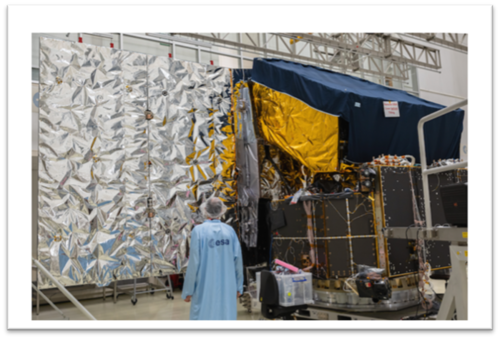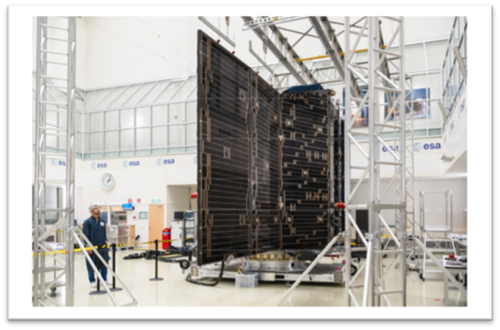PLATO spacecraft is complete and ready for rigorous tests
The PLATO spacecraft in one of the ESA clean rooms with one solar panel unfolded. This side will be facing away from the Sun. Credit: ©ESA
The Sun-facing side of the PLATO spacecraft in one of the ESA clean rooms with one solar panel unfolded. Credit: ©ESA
News from Oct 10, 2025
The PLATO (PLAnetary Transits and Oscillations of stars) satellite, centrepiece of the European Space Agency’s (ESA) upcoming mission for finding distant exoplanets, has now taken its final shape. At ESA’s test centre in the Netherlands, the spacecraft has been fitted with the last two crucial parts: First, a sunshield will protect the scientific instruments onboard from the solar glare. It will ensure that PLATO's 26 cameras are not heated by the Sun’s rays, and no stray-light enters the optics. Second, solar panels will supply all the on-board electronics with electricity. The panels will be folded up during launch, planned December 2026, and will be unfolded once PLATO reaches its observing position at the Lagrange point L2 of the Sun-Earth system, situated about 1.5 million kilometres away from Earth on the side opposite to the Sun. When unfolded, the spacecraft has a wingspan of circa nine meters.
Now that PLATO is completely assembled, it will face a series of tests. It will be vigorously shaken and blasted with deafening noise, to simulate conditions during the launch. Then, it will be subjected to the harsh vacuum of space in ESA’s Large Space Simulator, Europe’s largest cryo-vacuum chamber. Once the spacecraft has proven its reliability in this adverse environment, it will be prepared for shipping to the launch facility.
PLATO will use its 26 cameras to measure the brightness of hundreds of thousands of stars with unrivalled accuracy and thus to find signs of orbiting exoplanets.
The PLATO mission’s international scientific consortium is led by Professor Heike Rauer, planetary scientist at the Institute of Geological Sciences and the German Aerospace Center (DLR). The mission’s preparation is supported by scientists at the Freie Universität Berlin.
Contact
Prof. Dr. Heike Rauer, Planetary Science and Remote Sensing Group, Institute of Geological Sciences, Department of Earth Sciences, Freie Universität Berlin, and German Aerospace Center (DLR), Email: heike.rauer@fu-berlin.de
The contributions by Freie Universität Berlin to the PLATO mission are supported by German Federal Government via the German Space Agency at DLR (Grants 50OO1401, 50OP2103 and 50OP2104).

